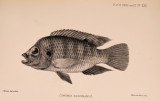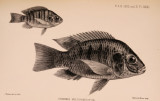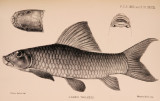| OCR Text |
Show 368 MR. W. F. LANCHESTER ON THE [Dec. 2, 1). miles. c. Hand and Carpus. Much as in D. merguiensis, but tubercles less prominent and more thickly placed. Two rows as in I), merguiensis. I), merguiensis. I), intermedins. 1). mixtus. Two rows of 11-12 Two rows of 11-12 As in 1). inter-granules, numerous ferous tubercles d. Fingers. 30 granules in external row. (?) and pili-icute 011 carpus. Palm similar, but the two rows number 8 externally, 5 internally. granules, and less numerous granules, with 1-2 hairs at bases only, on carpus. On palm the two rows number 2 5 - 27 externally, 10- 11 internal!}'. medius, but, on the carpus, the two rows number 14-15 each, and on the palm 10- 11 each. the 16-17 granules. The row of granules on the under margin of the immobile linger extends as far as the carpal joint. 25-27 granules. How of granules extends partly on to the hand. 24 granules. As in U. mergui-ensis. Inner process extends a little beyond the penultimate joint. Inner process extends to the anterior 5 of the penultimate joint. As in D. intermedins. c. Antennal scales. The inner process extends as far as the middle of the penultimate joint. From this table it may be seen that D. mixtus combines some of the characters of the other three species with characters of its own in such a way that it is difficult to regard it as a variety of any one of the other species, and necessary to regard it as a distinct, though closely allied form. IX. Genus CVe n o b it a Latr. 18. C(ENOBITA COMPRESSUS M.-Edw. Gmnobita compresses M.-E. Hist. Nat. Crust, ii. p. 241 (1837); Ortmann, Zool. Jahrb. Syst. vi. p. 318 (1892). Loc. Pulau Bidan, Penang. One specimen from Dolimn, two from Murex, one from Purpura, and numerous other individuals. Ortmann's diagnosis is deceptive in so far as the outer surface of the 3rd left leg is not quite smooth in large individuals, but, like the cephalothorax, finely granulated or tuberculated; the short stiff hairs springing from these tubercles in front at the base; the tubercles themselves being sometimes corneous at the tips. The same remark holds good also for some large specimens, in the Cambridge Museum, of C. rugosus from Torres Straits. On the last joint, however, in both species, the granulation is confined to the proximal | or 4- of the joint. Further, the ridge on the outer surface of the penultimate joint becomes rounder, the larger the individual. No doubt these characters are correlated with age. 19. CtENOBITA RUGOSUS M.-Edw. Ccenobita rugosus M.-E. Hist. Nat. Crust, ii. p. 241 (1837); Ortmann, Zool. Jahrb. Syst. vi. p. 317 (1892). |
































































































































































































































































































































